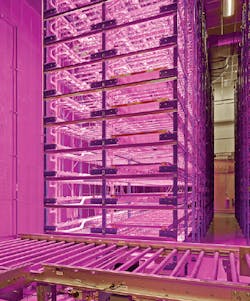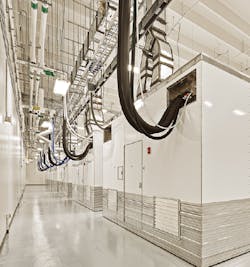You probably won’t find many presidents of successful contract manufacturing organizations gleefully running the forklift inside their manufacturing plants, but Barry Holtz is no ordinary leader—which is fitting because iBio is no ordinary biopharma facility. “Anyone can build monuments,” says Dr. Holtz. “But the fun comes in seeing them in action—being the one to push that green button. Building systems that work is the greatest reward.”
The iBio facility is a testament to what can be accomplished when efficiency is built into the design from the start. Formerly operated by Caliber Biotherapeutics, the Bryan, Texas facility was designed, constructed and fully functional in less than 18 months. The facility boasts meticulous design considerations, ranging from concepts as simple as locating parking lights across the street to avoid insect infestation to the sophistication of an automated, multilevel growing environment that uses proprietary LED lighting (Figure 1).
The 139,000-square-foot building is conveniently located in the “bio corridor” abutting the campus of Texas A&M University. The process was developed in response to a challenge from the Defense Advanced Research Projects Agency (DARPA). “Our first challenge was to design a commercial biotherapeutics facility using a plant-made pharmaceutical platform, and design the facility to be hardened, self-sufficient and have high containment,” explains Holtz. “The test was that DARPA sent us a gene sequence by email, then we had to make 50 million doses in 12 weeks, because that’s what stops a pandemic in the U.S.”
iBio’s proprietary plant-made pharmaceutical technology was licensed to Caliber for the project, which demonstrated successful use of the technology on a commercial scale.
In January 2016, iBio, together with investors Eastern Capital Ltd., purchased the Caliber facility and formed iBio CMO—a contract manufacturing organization for the development, scale-up and large-scale manufacturing of biologicals.
Figure 1: The multi-level growing environments are fitted with proprietary LED lighting that reduce growth time and lower costs by providing 166% more photic energy than conventional lighting while using 66$ less energy.
That summer, the FDA granted Orphan Drug Designation to iBio’s lead investigational biotherapeutic product, iBio-CFB03, for the treatment of systemic sclerosis. Also, iBio recently announced the successful application of its plant-based technologies to achieve the first milestone in its commercial development agreement with AzarGen Biotechnologies for the development and manufacture of an improved surfactant protein for treating neonatal respiratory distress syndrome (RDS).
Technology rules
iBio’s primary research, development and manufacturing system employs vacuum-infiltrated Nicotiana benthamiana plants—tobacco relatives indigenous to Australia—grown in a fully contained, hydroponic system for transient expression of recombinant proteins. In plain English, once the plants have been infiltrated with agrobacteria, the bacteria hijacks the protein-making functions of the plant, and the plant leaves replace a traditional bioreactor to become a “protein factory.” The plant biomass is then harvested and the resulting extract is purified through a downstream process similar to what you’d see in a typical biopharma facility (see "How it works" sidebar).
The iBio facility can grow more than 4 million plants hydroponically as in-process inventory, and can deliver more than 300 kg of finished therapeutic protein per year at full capacity. Technology transfer and scale-up is vastly simplified because the need to adapt cell lines to the scale of the bioreactor is eliminated in the plant-based process.
Simplification also equates to customer cost-savings. As a contract development and manufacturing organization (CDMO) using proprietary plant-made biopharmaceutical development and manufacturing technologies, iBio can take a potential protein into commercialization faster and more cost-effectively than traditional CDMOs. A recent, in-depth, technoeconomic peer-reviewed paper reported the cost of goods for a monoclonal antibody was estimated at $160/gram at a yearly production rate of 300 kg per year. Economical production at this smaller scale is difficult in CHO. And yet, the great majority of monoclonal antibodies coming forward have smaller total production requirements, between 10-120 kg.
The iBio Vertical Pharming manufacturing process, which is automated largely by Rockwell Automation control systems, involves three steps—plant production, plant infiltration and downstream purification in autonomous cleanrooms. “Everything is automated that can be automated,” Hottz says. “We don’t allow people to touch our plants.”
Using automation, “We seed 1,200 plants per tray, and then go into germination,” Holtz adds. The 55-ft, laminar air-flow room where germination takes place was designed using computational flow dynamics (CFD), and is temperature controlled to within 2 °F. The second, larger growth room is 14 layers high with a capacity of 1.2 million plants.
When the plants reach 8-10 g, they're placed upside down in an infecting liquid, evacuated to 1/3 of atmosphere, and brought back to atmospheric. “Agroinfiltration is where the magic happens,” says Holtz. “It’s where we infect the plant with the vector for a transient expression of new protein.” The plant’s leaves become bioreactors.
Once the plants are fully grown, their proteins are extracted in clean rooms using processes familiar to any biopharmaceutical operation. Seven autonomous clean rooms, called G-CON PODs (Figure 2), are fitted with air bearings, so they can be lifted an inch off the floor and moved with one hand. “Each clean room has 100% redundancy, and it’s all controlled by ControlLogix PLCs. We even have our own fire suppression in these rooms,” Holtz explains. The process is managed by a PlantPAx distributed control system.
- iBio scientists engineer vectors containing the target sequence within a viral replicon.
- The vector is transferred to an Agrobacterium host that efficiently introduces target DNA to the plant cell nucleus.
- The viral replicon directs the production of large amounts of target-specific messenger RNA in plant cells, which is translated into protein by the plant's own machinery for several days.
- Once the plants have been infiltrated with agrobacteria, the viral sequences of the launch vectors, along with the cloned target sequences, are massively amplified through the action of virally encoded enzymes. Translation of these recombinant viral vector mRNAs can result in the accumulation of gram quantities of target protein per kilogram of fresh plant tissue in less than a week.
- The plants accumulate high levels of target protein in their leaf and stem tissue. This expression of recombinant protein is termed "transient" expression because the target gene sequence is expressed as protein for a fixed period of time, and the foreign genes are not incorporated into the plant chromosome to result in the creation of transgenic plants.
- The plant biomass is harvested, homogenized and clarified to produce an extract containing the protein of interest. Proteins are further purified as required using conventional separation and chromatography steps.
Smart, collaborative design
Each G-CON POD is served by its own independently controlled, redundant HVAC system. The facility was designed in a parametric building information management (BIM) and estimation model using advanced three-dimensional, computer-aided-design (CAD) systems. The BIM process involves creating digital representations of the physical and functional characteristics of the facility. Several sophisticated software systems were used, including D-Profiler (a parametric 3D CAD-based estimating tool); Revit object-based 3D CAD design system; Navisworks for ‘in silico’ design conflict resolution; and Synchro Design timeline planning. This “virtual construction” allowed the design team to work out design problems and inefficiencies prior to actual construction. The 3D design software enabled the team to visualize concepts and simulate how the designs would perform.
The project was design-build. Often seen as a faster, more cost-effective alternative to traditional design-bid-build methods, this approach enables the design-build team to work under one contract with the project owner to provide design and construction services. “One entity, one contract, one unified flow of work from initial concept through completion, thereby reintegrating the roles of designer and constructor,” explains the Design-Build Institute of America.
The project design team was led by Beck Architecture, with pre-construction and construction teams from Beck Group. The design group also included EEA Engineering (mechanical and process) and a team from G-CON Manufacturing, which builds the autonomous, cleanroom PODs. Beck owned the BIM model. The design group worked directly with the mechanical and electrical contractors, Britt Rice Electric and Garrett Mechanical, who were also familiar with Revit.
Figure 2: Each downstream G-CON POD cleanroom is mounted on air bearings so it can be easily moved, and is served by its own independently controlled, redundant HVAC system.
During the build, the lead architect, lead mechanical engineer, CAD specialists in Revit, Navisworks and Synchro were onsite, as was the iBio QA team and Barry Holtz himself. This onsite collaboration, according to Holtz, allowed the team to “process change orders in hours instead of days, and design many systems on the fly, including the proprietary lighting that was developed during the build and the laminar flow wall optimization. “The design-build process, combined with the skill of the team and direct participation of the owners, allowed this technical achievement to be made real and operational in record time,” reflects Bryan Jones, principal and lead architect at Beck.
Process efficiency is built in
Along with providing a necessary process input at lower energy consumption, the proprietary LED lights permit higher environmental temperature uniformity. The lights are also low-voltage and waterproof.
Vertically designed, space-efficient grow rooms house the 14 levels of racks of N. benthamiana plants. Due to the 40-foot height of the ceilings and the need for plants to be maintained at uniform temperatures, the grow rooms had to be constructed as horizontal laminar airflow rooms—the facility boasts the two largest laminar flow systems in the world. The growing rooms circulate very large volumes of air with low temperature differentials over the 100 feet between the walls, so they can maintain temperatures within the required 2 °F.
EEA assisted in constructing the perforated-plate supply and return air plenum walls on each side of the grow rooms. CFD modeling was also used to design specific perforation patterns, and prove the concept would work prior to installation.
The facility’s novel LED lighting system has proven that it can reduce germination and pre-infiltration growth time from six weeks to five weeks, as well as reduce energy costs. “A photon is a terrible thing to waste,” jokes Holtz, as he points out that the LED lighting provides 166% more photic energy on plants than conventional lighting, for 66% of the energy cost.
All downstream processing occurs in G-CON’s GMP manufacturing PODs. Because their air bearings enable them to be moved easily, the self contained units also gave iBio a flexible, cost-effective approach to construction. The POD shells were transported to the iBio site by flatbed truck and moved in and connected in a matter of hours.
The PODs provide iBio with “ultimate flexibility,” says Holtz, enabling rapid reconfiguration of the downstream processes without disrupting ongoing operations an the facility. The PODs offer a complete control system thanks to ControlLogix, so each POD can be served by its own independent HVAC system.
Hands-on approach
Under the careful scrutiny and supervision of Holtz and his team, every detail of the iBio facility was scrutinized, optimized and customized. “In this business, your hands need to be connected to your head,” explains Holtz. Coming from a world-renowned pioneer in plant-made pharmaceuticals, who also got behind the wheel of the bulldozer during groundbreaking, this sentiment couldn’t be more believable.
The resulting execution of an 18-month build is a shining example of design innovation, rapid facilities systems integration and highly efficient construction management—with the added bonus of the ability to develop medical countermeasures to rapidly respond to biothreats and outbreaks.
Karen Langhauser is chief content director, Pharmaceutical Manufacturing. Mike Bacidore is editor in chief, Control Design.

Leaders relevant to this article:





